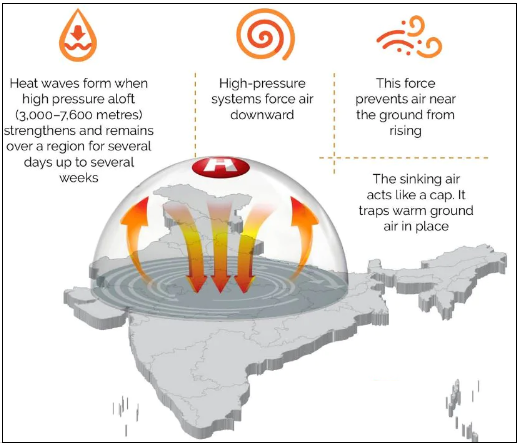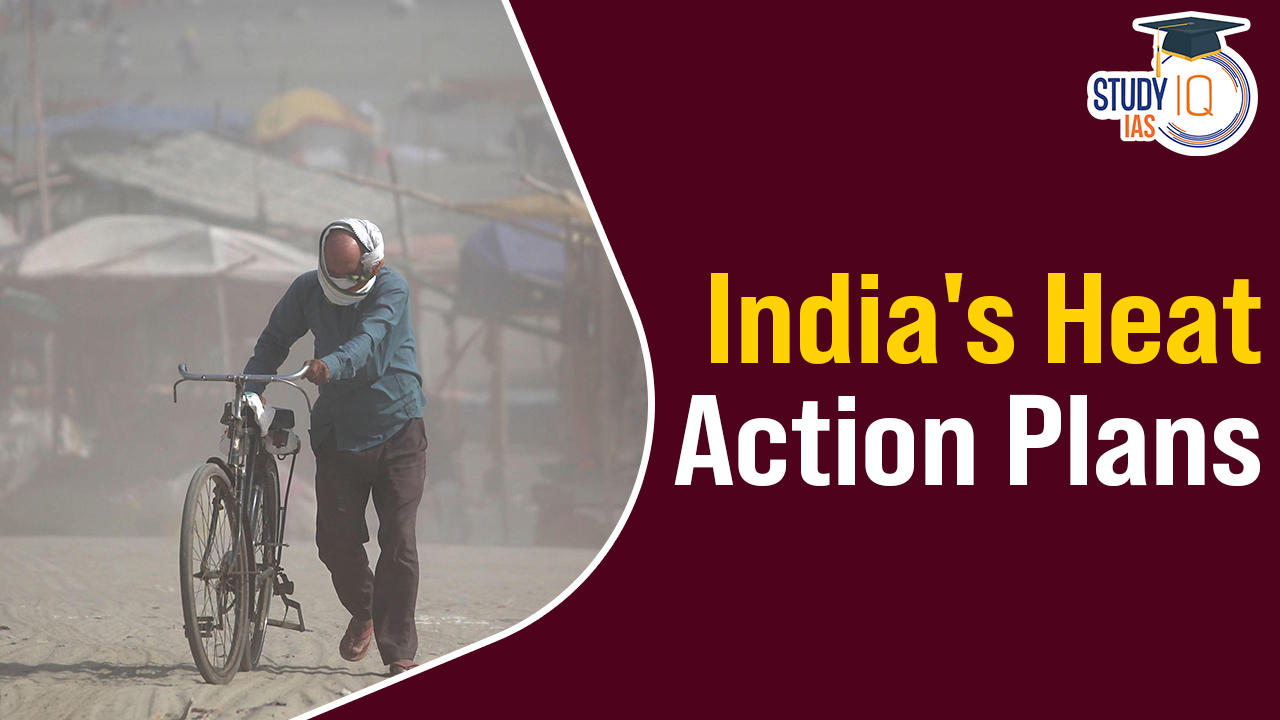Table of Contents
Context: According to a 2024 study by the Council on Energy, Environment and Water (CEEW), over 50% of Indian districts—home to more than 1 billion people—are at high to very high risk from extreme heat. This alarming trend highlights not only a public health emergency but also a governance and urban planning crisis, exposing the urgent need to reimagine India’s Heat Action Plans (HAPs).
Heat Waves: An Overview
- Heat waves are extreme events in which hot temperatures in summer months persist for a relatively long period.
- In India, heatwaves typically occur between March and June, and in some rare cases even extend till July.

What are Heat Action Plans (HAPs)?
- Heat Action Plans (HAPs) are localised policy tools designed to reduce the human and economic impacts of extreme heat.
- First introduced in 2013 in Ahmedabad, they are now being adopted by over 250 cities and districts in 23 heat-prone states.
- They aim to coordinate early warnings, public awareness, health preparedness, and adaptive urban strategies during heat waves.
Criterion for declaring a heatwave in India (as per IMD)
Heat wave is considered if the maximum temperature of a station reaches at least 40°C or more for the Plains and at least 30°C or more for Hilly regions.
| Based on Departure from Normal | Based on Actual Maximum Temperature |
|
|
| Note: If the above criteria are met at least in 2 stations in a Meteorological sub-division for at least two consecutive days, then the heatwave will be declared on the second day. | |
| Criteria for describing a heatwave in coastal stations: When maximum temperature departure is 4.50C or more from normal, a Heat Wave may be described, provided the actual maximum temperature is 370C or more. | |
How Are We Tackling Heatwaves?
- Heat Action Plans (HAPs): Governments at various levels have developed HAPs to increase preparedness and mitigate adverse impacts of extreme heat. These plans outline strategies and measures to prepare for, address, and recover from heatwaves.
- Components of HAPs:
-
- Vulnerability Assessment: Identifies regions requiring immediate attention.
-
- Response Plan: Recommends mitigating measures before, during, and after a heatwave.
-
- Role Assignment: Specifies responsibilities of various departments and agencies.
Recommendations of HAPs
- Early Warning Systems: Utilize forecasts to alert the public and authorities about impending heatwaves.
- Public Education: Conduct campaigns to raise awareness about heatwave risks.
- Infrastructure Development: Build heat shelters, cooling centers, and ensure access to clean drinking water.
- Healthcare Preparedness: Equip hospitals with supplies and trained staff to handle heat-related illnesses.
Issues Faced by Heat Action Plans (HAPs)
- Lack of Long-Term Vision: Most plans focus on short-term or reactive measures (e.g., water stations, advisories), not long-term climate resilience.
- Structural reforms like climate-sensitive housing or urban redesign are largely missing.
- Underfunding and Poor Coordination: Long-term measures are often underfunded, uncoordinated, or absent, limiting their overall effectiveness.
- Top-Down Planning with Limited Local Involvement: HAPs are often developed without community input, ignoring local vulnerabilities and needs.
- Uneven Implementation and Exclusion: Densely populated and low-income urban areas are excluded from tree-planting or cooling strategies due to land and infrastructure constraints.
- Narrow Framing of the Problem: Heat is still treated primarily as a public health issue, whereas it intersects with labour rights, housing, urban planning, and environmental justice.
Challenges in Addressing Heatwaves Effectively
- Local Context: Current national thresholds for heatwaves need to be adapted to local conditions considering factors like humidity, urban heat island effect, and community vulnerabilities.
- Inconsistent Methods: Methods for vulnerability assessments vary across HAPs, necessitating a transition to robust climate risk assessments.
- Vulnerable Populations: Targeted interventions for vulnerable groups are essential, considering socio-economic differences and informal employment patterns.
- Resource Allocation: Dedicated budgets and financial mechanisms are required to implement HAPs effectively and ensure protection for vulnerable populations.
- Breaking Down Silos: Integration of HAPs with broader urban resilience and climate adaptation plans can improve effectiveness and resource pooling.
- Long-term Measures: Emphasis on nature-based solutions alongside infrastructure development is crucial for the sustainability of HAPs.
What Can Be the Solutions?
- Mandate and Standardise HAPs: Make HAPs legally binding and develop national guidelines to standardise and monitor quality.
- Invest in Long-Term Infrastructure: Promote climate-resilient urban planning, such as:
- Reflective building materials
- Green roofs
- Tree-lined streets
- Water body restoration
- Inclusive and Participatory Planning: Involve local communities, urban poor, and workers in the design and implementation of HAPs.
- Targeted Cooling for Vulnerable Areas: Prioritise cooling interventions in high-density informal settlements through public cooling shelters, water access, and tree cover.
- Integrated Approach Across Sectors: Link HAPs with housing, labour, healthcare, and disaster management policies to tackle heat stress holistically.
- Data and Monitoring Systems: Strengthen systems to track heat-related illnesses and deaths, and use data to guide interventions.
Conclusion
As heatwaves become more frequent and severe, the importance of effective heat action plans cannot be overstated. By addressing the challenges outlined above and implementing targeted measures, India can enhance its readiness to tackle the impacts of extreme heat and protect its population, especially the most vulnerable segments, from heat-related hazards.


 Places in News for UPSC 2026 for Prelims...
Places in News for UPSC 2026 for Prelims...
 Lake Natron: Location, Features, Wildlif...
Lake Natron: Location, Features, Wildlif...
 Erra Matti Dibbalu Added to UNESCO Tenta...
Erra Matti Dibbalu Added to UNESCO Tenta...

























